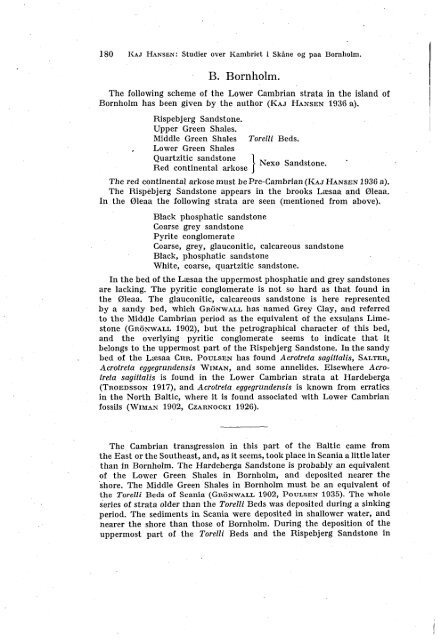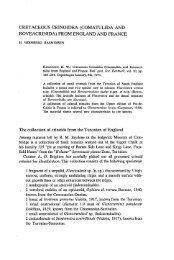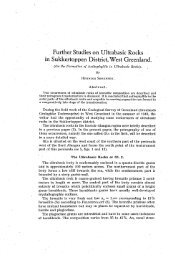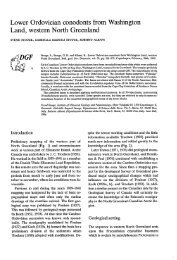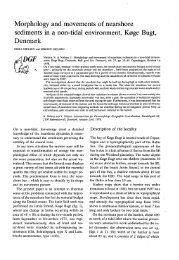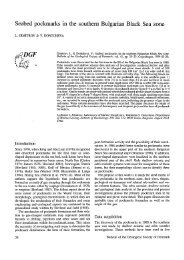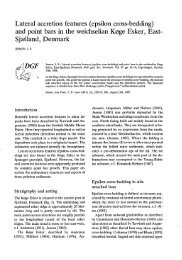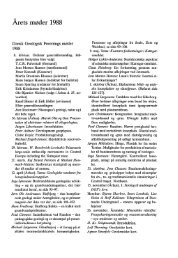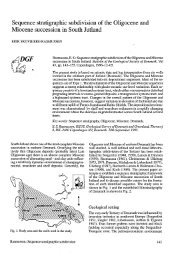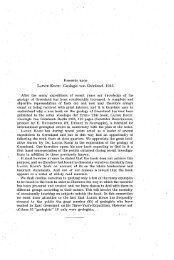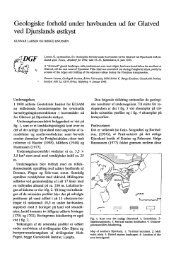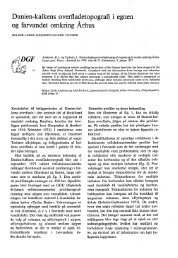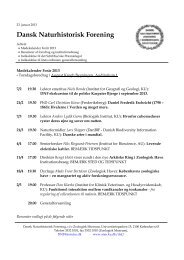Sammenlignende Studier over Kambriet i Skåne og paa Bornholm. I ...
Sammenlignende Studier over Kambriet i Skåne og paa Bornholm. I ...
Sammenlignende Studier over Kambriet i Skåne og paa Bornholm. I ...
You also want an ePaper? Increase the reach of your titles
YUMPU automatically turns print PDFs into web optimized ePapers that Google loves.
180 KAJ HANSEN: <strong>Studier</strong> <strong>over</strong> <strong>Kambriet</strong> i <strong>Skåne</strong> <strong>og</strong> <strong>paa</strong> <strong>Bornholm</strong>.<br />
B. <strong>Bornholm</strong>.<br />
The following scheme of the Lower Cambrian strata in the island of<br />
<strong>Bornholm</strong> has been given by the author (KAJ HANSEN 1936 a).<br />
Rispebjerg Sandstone.<br />
Upper Green Shales.<br />
Middle Green Shales Torelli Beds.<br />
Lower Green Shales<br />
Quartzitic sandstone 1 .. „ , .<br />
„ , .. . , , j Nexø Sandstone.<br />
Red continental arkose J<br />
The red continental arkose must be Pre-Cambrian (KAJ HANSEN 1936 a).<br />
The Rispebjerg Sandstone appears in the brooks Læsaa and Øleaa.<br />
In the Øleaa the following strata are seen (mentioned from above).<br />
Black phosphatic sandstone<br />
Coarse grey sandstone<br />
Pyrite conglomerate<br />
Coarse, grey, glauconitic, calcareous sandstone<br />
Black, phosphatic sandstone<br />
White, coarse, quartzitic sandstone.<br />
In the bed of the Læsaa the uppermost phosphatic and grey sandstones<br />
are lacking. The pyritic conglomerate is not so hard as that found in<br />
the Øleaa. The glauconitic, calcareous sandstone is here represented<br />
by a sandy bed, which GRONWALL has named Grey Clay, and referred<br />
to the Middle Cambrian period as the equivalent of the exsulans Limestone<br />
(GRONWALL 1902), but the petr<strong>og</strong>raphical character of this bed,<br />
and the <strong>over</strong>lying pyritic conglomerate seems to indicate that it<br />
belongs to the uppermost part of the Rispebjerg Sandstone. In the sandy<br />
bed of the Læsaa CHR. POULSEN has found Acrotreta sagiltalis, SALTER,<br />
Acrotreta eggegrundensis WIMAN, and some annelides. Elsewhere Acrotreta<br />
sagittalis is found in the Lower Cambrian strata at Hardeberga<br />
(TROEDSSON 1917), and Acrotreta eggegrundensis is known from erratics<br />
in the North Baltic, where it is found associated with Lower Cambrian<br />
fossils (WIMAN 1902, CZARNOCKI 1926).<br />
The Cambrian transgression in this part of the Baltic came from<br />
the East or the Southeast, and, as it seems, took place in Scania a little later<br />
than in <strong>Bornholm</strong>. The Hardeberga Sandstone is probably an equivalent<br />
of the Lower Green Shales in <strong>Bornholm</strong>, and deposited nearer the<br />
shore. The Middle Green Shales in <strong>Bornholm</strong> must be an equivalent of<br />
the Torelli Beds of Scania (GRONWALL 1902, POULSEN 1935). The whole<br />
series of strata older than the Torelli Beds was deposited during a sinking<br />
period. The sediments in Scania were deposited in shallower water, and<br />
nearer the shore than those of <strong>Bornholm</strong>. During the deposition of the<br />
uppermost part of the Torelli Beds and the Rispebjerg Sandstone in


